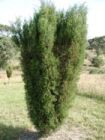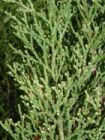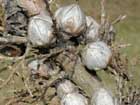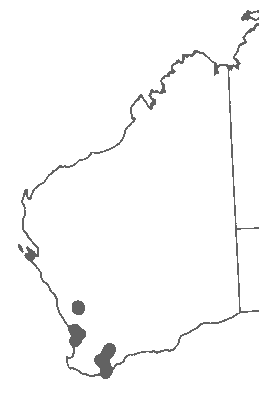Callitris pyramidalis
Sweet ex J. Piggin & J.J. Bruhl 2010
Common names
Swan River cypress, swamp cypress (Farjon 2005), King George's cypress-pine (Silba 1986).
Taxonomic notes
Many authorities still name this taxon Actinostrobus pyramidalis, for so it was known from 1845 until (for me) 2020; see Callitris for discussion of why it is now placed in Callitris.
Syn.: Callitris pyramidalis Miquel 1845; Callitris actinostrobus F. Muell. 1860, nom. illeg.; Frenela actinostrobus (F. Muell.) F. Muell. 1871, nom. illeg. T: cited as: Gordon River, Perth and Wellington, Nov. 1840, Sept. 1841, L.Preiss 1311; holo: not traced (Hill 1998).
Description
A narrowly conical shrub or small tree to 8 m tall with erect, closely arranged branches. Bark brown, smooth. Branchlets divided into long, straight, slender branchlets. Juvenile leaves often glaucous, 7-8 mm. long, rarely persistent on mature trees. Adult leaves scale-like, ovate, apically spreading, up to 12 mm. long, in 6 ranks, dark green, pointed, somewhat decurrent, slightly keeled. Male cones cylindrical, 3-5 mm long, 1.5-2 mm diameter, with 16-18 ovate scales; microsporophylls 2-4. Female cone globose to ovoid, rounded or obtuse, on a short peduncle, gray-brown, 12-15 mm. diameter, with 6 valvate scales; scales thin, obtuse or acute, slightly overlapping, apically incurved or erect, rarely spreading when open; with large rounded or nearly ovate basal bracts. Seeds tan or yellowish-brown, resinous, 5-7 mm. long, wings 1.5-1.9 mm. wide. Cotyledons 2, blue-green, 9-15 mm. long by 1.5-2 mm. wide, apex bluntly acute, stem 0.5-1 mm. thick. 2n = 22 (Silba 1986, Hill 1998).
Distribution and Ecology
Australia: Western Australia, "Endemic and locally frequent in shrublands in sandplain country, from near Watheroo south to the Albany district, south-western WA." Cited collections (presumably wild plants) include the south shore of Lake Chinocup, Cannington Swamp at University Reserve, and the corner of Madgingarra Road, near Maunchel Springs (Hill 1998).
Zone 10 (cold hardiness limit between -1°C and +4.4°C) (Bannister and Neuner 2001).
Remarkable Specimens
No data as of 2023.03.03.
Ethnobotany
Observations
Remarks
The epithet refers to the pyramidal crown of many plants.
Citations
Piggin, J., and J.J. Bruhl. 2010. Phylogeny reconstruction of Callitris Vent. (Cupressaceae)
and its allies leads to inclusion of Actinostrobus within Callitris. Australian Systematic Botany 23:69-93.
See also
Baker, R.T. and H.G. Smith. 1910. Res. Pines Australia 290 (Illustrations).
Bennett, E.M. 1987. in N.G. Marchant et al., Fl. Perth Region 1: 53, fig. 6 (Illustrations).
Blackall, W.E. and B.J. Grieve. 1954. How to Know W. Austral. Wildflowers. 1: 6 (Illustrations).
Farjon (2005) provides a detailed account, with illustrations (as Actinostrobus pyramidalis).
Hair, J.B. 1968. New Zealand Journal of Botany 6: 272-284 (Figs 163, 195A-D).
Krussmann, G. 1985. Manual of Cultivated Conifers 2nd edition, 47, fig. 15 (Illustrations).
Miquel, F.A.G. 1845. Cupressinae Richard. V.1, p.643-645 in J.G.C. Lehmann, Plantae Preissianae. Hamburg.




